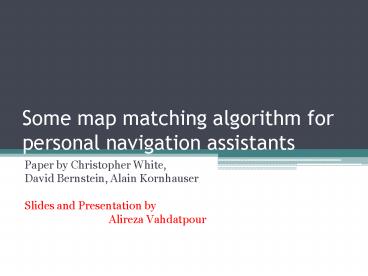Some map matching algorithm for personal navigation assistants - PowerPoint PPT Presentation
1 / 21
Title:
Some map matching algorithm for personal navigation assistants
Description:
Goal is to determine the set of streets that contain Pt. Problem Statement ... Uses connectivity information to locate candidate arcs for matching (in addition ... – PowerPoint PPT presentation
Number of Views:108
Avg rating:3.0/5.0
Title: Some map matching algorithm for personal navigation assistants
1
Some map matching algorithm for personal
navigation assistants
- Paper by Christopher White,
- David Bernstein, Alain Kornhauser
- Slides and Presentation by
- Alireza Vahdatpour
2
Outline
- Background
- Problem statement
- Literature review
- Four solutions
- Evaluation
- Results
3
Background
- Personal Navigation Assistants
- Reconcile the users location with the underlying
map - Users location coming from GPS (inacurate)
- Underlying map
- Could be inaccurate in some cases
- Accurate map may not be available
- Limited device memory
- Security issue
4
Problem Statement
- Map matching algorithm to reconcile inaccurate
locational data with an inaccurate map - A person/vehicle is moving along a finite set of
streets - We are provided by an estimate of his location in
times T0, , Tt (denoted by Pt) - Goal is to determine the set of streets that
contain Pt
5
Problem Statement
- Street system is usually represented by a network
- Network consists of a set of curves (arc)
- Arcs are piece-wise linear
- Arcs can completely represented by a sequence of
nodes A (A1, A2, ., An-1) - The goal is to match the estimated points Pt with
and arc A
6
Problem Statement
- Example
7
Literature review
- Map matching as a search problem
- Match Pt to the closest arc
- Algorithms to find the closest match are called
range query - Pros
- Fast, easy to implement
- Cons
- Inaccurate
8
Literature review
- Example
9
Literature review
- Map matching as statistical estimation
- Attempt to fit a curve to the sequence of
estimated locations - The curve is considered to lie on the network
- Perfect if the model of the motion is simple
(straight lines) - Not easy to model motions dictated by networks
(streets)
10
Literature review
- Example
11
Algorithm 1
- Find nodes that are close to the GPS estimated
locations - Find the set of arcs that are incident to these
nodes - Find the closest of these arcs and project the
point onto that arc
12
Algorithm 1
- Two cases
13
Algorithm 1
- Cons
- Do not use historical data
- Unstable
14
Algorithm 2
- Algorithm 1 Heading information
- Example benefit
- Will not match a point to an arc that is
perpendicular to the current direction of travel
15
Algorithm 3
- Algorithm 2 topological information
- Uses connectivity information to locate candidate
arcs for matching (in addition to range query) - Cons
- One bad match can lead to a sequence of bad
matches
16
Algorithm 4
- Algorithm 3 Curve to curve matching
- Locates candidate nodes the same way as algorithm
3 - Constructs piece-wise linear curves from the set
of paths originating from that node - Construct piece-wise linear curve from GPS points
- Calculate distance between this curve ad network
curves - Return the closest match
17
Algorithm 4
- Example
18
Evaluation
- Driving a vehicle ,utilized with GPS receiver, in
Mercer county, New Jersey - Limited to 4 routes
19
Results
- Accuracy of each algorithm vs. route
20
Results
- Comparison of Algorithm 1 and Algorithm 2
21
Results
- All algorithms work better on longer routes
- All algorithms work better with better GPS
points - Higher speed is better































